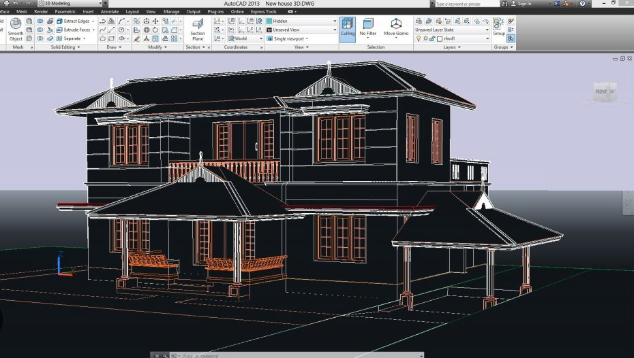
Auto CAD Mechanical Course in Visakhapatnam | An AutoCAD Mechanical course teaches the specialized version of AutoCAD software designed for mechanical engineers and drafters. It covers industry-specific tools and libraries to accelerate the design and drafting of mechanical components, products, and machines. Courses are available for beginners as well as professionals looking to update their skills.
What you will learn
Auto CAD Mechanical Course in Visakhapatnam | A typical course for mechanical engineers includes modules that build from fundamental concepts to advanced techniques:
- Fundamentals: Learn the basics of AutoCAD, including the user interface, workspaces, and standard design practices.
- 2D Drafting: Master the creation of geometric shapes, editing tools (trim, mirror, array), and standard mechanical drafting techniques. You will also learn about isometric drawings.
- 3D Modeling: Explore how to create 3D solid models using techniques like extrusion and revolution, as well as applying materials.
- Annotations and Dimensioning: Learn how to create dimensions, add annotations, use tolerances, and apply standard mechanical symbols.
- Parts and Standards: Work with a library of over 700,000 standard parts (gears, bearings, fasteners) and use tools that comply with international drafting standards like ANSI, ISO, and DIN.
- Bill of Materials (BOM): Learn to automatically generate parts lists and ballooning for assembly drawings.
- Productivity Tools: Understand how to use productivity features, layer management, and external references to streamline your workflow.
How to choose a course

To find the best course for your needs, consider these factors:
- Format: Decide between a self-paced online course for flexibility or an in-person, instructor-led class for direct support and hands-on guidance.
- Curriculum: Check if the syllabus covers both 2D and 3D modeling and aligns with your career goals, whether you are a beginner or an experienced professional.
- Certification: Look for courses that offer industry-recognized certification, such as the Autodesk Certified User (ACU) or Autodesk Certified Professional (ACP), to validate your skills to employers.
- Hands-on Practice: Prioritize courses that include practical projects, assignments, and exercises to apply what you learn to real-world scenarios.
- Support: Consider the level of support offered, such as lifetime access to course materials, Q&A sessions, or placement assistance.
Auto CAD Mechanical Course in Visakhapatnam | Of course. Here is a comprehensive and structured outline for an AutoCAD Mechanical Course, designed to take a student from absolute beginner to a proficient user capable of creating professional mechanical engineering drawings.
Course Title: AutoCAD Mechanical Mastery: Precision Design for Mechanical Engineering
Target Audience: Auto CAD Mechanical Course in Visakhapatnam | Mechanical engineering students, drafters, designers, machinists, mechanical engineers, and anyone involved in creating technical drawings for manufacturing, assembly, and design.
Prerequisites:
- Basic computer literacy (Windows OS).
- A fundamental understanding of mechanical engineering concepts (e.g., parts, assemblies, dimensions, tolerances) is highly beneficial.
- No prior CAD experience is required.
Course Goal: Auto CAD Mechanical Course in Visakhapatnam | To equip students with the skills to efficiently create, modify, annotate, and manage standard-compliant mechanical drawings using the specialized toolsets in AutoCAD Mechanical.
Detailed Course Modules

Module 1: Introduction to AutoCAD Mechanical & The UI
- 1.1 What is AutoCAD Mechanical? Understanding the difference between vanilla AutoCAD and the Mechanical vertical. Auto CAD Mechanical Course in Visakhapatnam | Overview of its specialized tools for mechanical design.
- 1.2 The User Interface: Navigating the Ribbon, Quick Access Toolbar, Command Line, and Status Bar.
- 1.3 The Mechanical Workspace: Switching to and customizing the dedicated Mechanical workspace. Understanding the Mechanical Browser for managing structure and layers.
- 1.4 File Management: Creating, opening, and saving drawings. Understanding DWG and DWT (template) files.
Module 2: Fundamental Drawing & Modification Commands
- 2.1 Drawing Tools: Auto CAD Mechanical Course in Visakhapatnam | Precision drawing using Line, Circle, Arc, Rectangle, Polygon, Polyline.
- 2.2 Drafting Settings: Mastering Snap, Grid, Ortho, Polar Tracking, and Object Snap for accurate geometry creation.
- 2.3 Modification Tools: Moving, Copying, Rotating, Mirroring, Scaling, Trimming, Extending, Fillet, and Chamfer.
- 2.4 Layers and Object Properties: Using the Mechanical layer system (AM_0 to AM_12) and its standards. Controlling color, linetype, and lineweight.
Module 3: The Power of Standard Parts
- 3.1 Introduction to the Content Library: The heart of AutoCAD Mechanical. Accessing standard parts (ANSI, DIN, ISO, JIS, etc.).
- 3.2 Inserting Standard Parts: Placing bolts, screws, nuts, washers, pins, keys, and bearings.
- 3.3 Intelligent Parts: How these parts are “smart” – they carry information, can generate bills of materials (BOM), and automatically create holes upon insertion.
- 3.4 Shaft Generator: Designing and detailing complex shafts with keys, grooves, and shoulders using a dedicated tool.
Module 4: Dimensioning and Annotation
- 4.1 Mechanical Dimensioning Tools: Using Power Dimensioning for baseline, continued, ordinate, and chamfer dimensions.
- 4.2 Annotation & Symbols: Adding geometric tolerances (GD&T), surface texture symbols, weld symbols, datums, and feature control frames.
- 4.3 Hole Charts and Hole Lists: Automatically creating charts that document the size, type, and location of all holes in a view.
- 4.4 Centerlines and Construction Lines: Using automated tools to add center marks, centerlines, and hidden lines to holes and cylindrical features.
Module 5: Creating Production Drawings
- 5.1 Creating Views: Generating orthographic base views, projected views, section views, and detail views from a model (if working with 3D).
- 5.2 Layouts and Viewports: Setting up drawing sheets (Layout tabs) with title blocks and multiple scaled viewports.
- 5.3 Plotting and Publishing: Configuring page setups, plot styles (CTB/STB), and outputting drawings to PDF or physical plotters.
- 5.4 Drawing Standards: Ensuring compliance with company or international standards (e.g., ISO, ASME).
Module 6: Assembly & Bill of Materials (BOM)
- 6.1 Assembling Components: Auto CAD Mechanical Course in Visakhapatnam | Using external references (Xrefs) to manage large assemblies composed of multiple part drawings.
- 6.2 Ballooning: Automatically adding numbered balloons to parts in an assembly drawing.
- 6.3 Bill of Materials (BOM): Using the BOM tool to automatically generate and manage parts lists. The BOM is linked to the balloons and the parts themselves.
- 6.4 Parts List Editing: Adding, modifying, and sorting entries in the BOM.
Module 7: Calculation Tools

- 7.1 Finite Element Analysis (FEA) Lite: Performing basic stress analysis on beams and shafts to calculate deflection, bending moment, and stress.
- 7.2 Shaft Calculation: Analyzing shafts for strength and fatigue based on applied loads and materials.
- 7.3 Cam Design: Creating and calculating the geometry of disc cams.
Module 8: Productivity Tools & Customization
- 8.1 Design Reuse: Using the Mechanical Content library to save and reuse custom parts.
- 8.2 Tool Palette Customization: Creating custom tool palettes for frequently used commands, blocks, and parts.
- 8.3 Command Macros: Introduction to creating simple macros to automate repetitive tasks.
- 8.4 Drawing Comparison: Using the DWG Compare tool to quickly identify differences between two versions of a drawing.
Module 9: Capstone Project – From Sketch to Production Drawing
- Students will create a complete set of drawings for a mechanical assembly (e.g., a gearbox, a piston assembly, a clamp fixture).
- Project Requirements:
- Create detailed part drawings for each component, with all necessary views, dimensions, and tolerances.
- Create an assembly drawing showing all parts assembled, with balloons.
- Generate a complete Bill of Materials (BOM) from the assembly.
- Use standard parts from the content library (e.g., bolts, bearings).
- Apply appropriate annotation and symbols (e.g., surface finish, GD&T).
- Set up a title block and plot the final drawings to a multi-sheet PDF.
Recommended Tools & Version
- Software: AutoCAD Mechanical (Latest version or one version prior, available via Autodesk Education Community for free for students and educators).
- Resources: Practice files, standard parts libraries, and custom title block templates.
Learning Outcomes

Upon completion, students will be able to:
- Navigate the AutoCAD Mechanical interface and workspaces efficiently.
- Create precise 2D geometric sketches using appropriate drafting settings.
- Leverage the power of the standard parts library to quickly add intelligent mechanical components.
- Apply industry-standard dimensioning, tolerancing, and annotation to drawings.
- Generate section views, detail views, and other production drawing elements.
- Create assembly drawings with automated ballooning and Bill of Materials (BOM).
- Perform basic engineering calculations on designed components.
- Configure and plot standard-compliant drawing sets for manufacturing.
- Utilize productivity tools to drastically reduce drawing time and improve accuracy.
Auto CAD Mechanical Course in Visakhapatnam | This course is intensely practical, focusing on the specific tools that make AutoCAD Mechanical a powerhouse for mechanical design, moving far beyond the capabilities of standard AutoCAD. The capstone project ensures students can synthesize all skills into a professional workflow.



